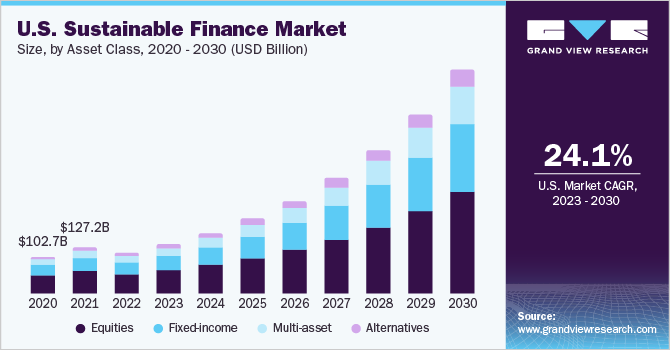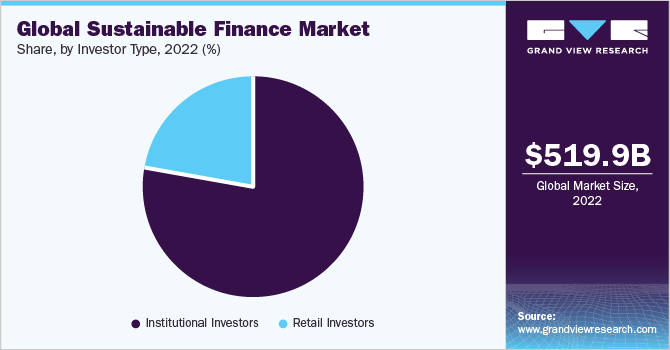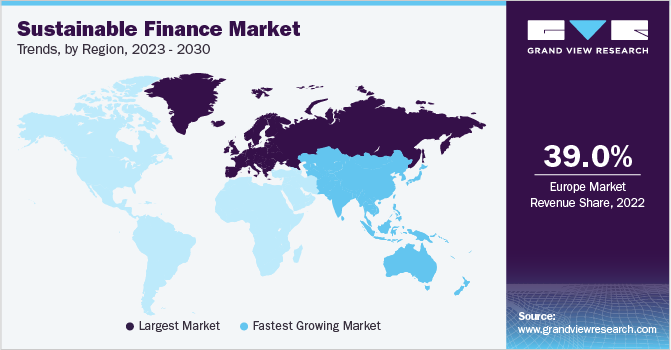- Home
- »
- Next Generation Technologies
- »
-
Sustainable Finance Market Size And Share Report, 2030GVR Report cover
![Sustainable Finance Market Size, Share & Trends Report]()
Sustainable Finance Market Size, Share & Trends Analysis Report By Asset Class, By Offerings, By Investment Style, By Investor Type, By Region, And Segment Forecasts, 2023 - 2030
- Report ID: GVR-4-68040-098-2
- Number of Report Pages: 120
- Format: PDF, Horizon Databook
- Historical Range: 2017 - 2021
- Forecast Period: 2023 - 2030
- Industry: Technology
Report Overview
The global sustainable finance market size was estimated at USD 519.88 billion in 2022 and is expected to grow at a compound annual growth rate (CAGR) of 22.6% from 2023 to 2030. The sustainable finance Asset Under Management (AUM) was valued at USD 37.80 trillion in 2022. The growing awareness and concern about environmental and social issues, such as climate change, resource depletion, and social inequality, is expected to boost the market’s growth. This heightened awareness has increased the demand for sustainable finance solutions as individuals, businesses, and institutions seek to align their investments with their values and contribute to a more sustainable future. Moreover, regulatory frameworks and government initiatives are playing a crucial role in driving the market’s growth.

Many countries have implemented policies and regulations encouraging sustainable investment practices, such as tax incentives, disclosure requirements, and sustainability reporting standards. These regulatory measures create a supportive environment for sustainable finance and incentivize market participants to incorporate sustainability factors into their investment decisions. Furthermore, investors are increasingly recognizing the financial benefits of sustainable finance. It is no longer seen as just an ethical choice but also a strategic one.
Sustainable investments have demonstrated competitive financial performance and risk mitigation potential, attracting investors seeking financial returns and positive environmental and social impacts. This shift in investor preferences has resulted in a surge in sustainable investment products and strategies, driving the growth of the sustainable finance industry. In addition, technological advancements and data analytics have played a significant role in driving the market. The availability of data on Environmental, Social, and Governance (ESG) factors has improved, enabling investors and financial institutions to assess the sustainability performance of companies and investment portfolios more accurately.
Technological tools and platforms have also facilitated the integration of ESG considerations into investment processes, making sustainable finance more accessible and efficient. In addition, companies and organizations increasingly recognize the importance of sustainability in their long-term business strategies. The adoption of sustainable practices not only helps mitigate risks but also enhances brand reputation, customer loyalty, and employee engagement. This corporate sustainability trend has increased the demand for sustainable finance solutions to support green projects, sustainable supply chains, and responsible business practices.
However, the market is restrained by the lack of standardized and globally recognized definitions, metrics, and reporting frameworks for sustainability. This creates challenges in comparing and evaluating the sustainability performance of different companies and investment products. To overcome this restraint, efforts are being made to develop common standards and frameworks. For instance, initiatives like the Task Force on Climate-related Financial Disclosures (TCFD) and Global Reporting Initiative (GRI) have provided guidelines for companies to disclose their sustainability-related information. In addition, collaborations among financial institutions, industry associations, and regulatory bodies are working towards harmonizing sustainability reporting requirements and promoting the adoption of globally recognized frameworks.
COVID-19 Impact Analysis
The COVID-19 pandemic has positively impacted the sustainable finance market in several ways. First and foremost, it has brought increased attention and awareness to ESG factors among investors and financial institutions. The crisis has highlighted the importance of sustainability and resilience in the face of global challenges. As a result, there has been a growing recognition of the need to align investments with sustainable goals and support businesses to be more resilient for future crises. Furthermore, the pandemic has accelerated the integration of sustainability into investment strategies. Investors have become more conscious of the risks associated with unsustainable practices and are increasingly seeking sustainable investment options that generate long-term value.
Asset Class Insights
The equities segment dominated the market in 2022 and accounted for a revenue share of more than 48.0%. Equities allow investors to actively engage in sustainable investing and support companies that demonstrate strong ESG practices. Moreover, equities offer a higher liquidity level than other asset classes in the sustainable finance industry. Investors can easily buy and sell equity securities, allowing for greater flexibility and responsiveness to market conditions. This liquidity makes equities an attractive choice for both institutional and individual investors seeking exposure to sustainable investments.
The multi-asset segment is anticipated to register significant growth over the forecast period. Multi-asset strategies offer investors diversification across different asset classes, including equities, fixed income, real estate, and alternative investments. This diversification helps mitigate risk and provides a more balanced portfolio, appealing to investors seeking a comprehensive approach to sustainable investing. Moreover, multi-asset strategies allow for flexible capital allocation to various sustainable investment opportunities.
Offerings Insights
The equity funds segment dominated the market in 2022 and accounted for a revenue share of more than 32.0%. The sustainable equity fund has emerged as a critical driver in the growth of the sustainable finance industry. This fund strategically invests in the stocks of large- and mid-cap companies that demonstrate strong financial performance and adhere to specific social and sustainability criteria. By focusing on sustainable business practices and considering ESG factors, the sustainable equity fund aims to achieve positive long-term capital appreciation while promoting sustainability characteristics. This fund exemplifies the increasing demand for investment options prioritizing ESG factors and aligning with investors' sustainability goals.
The ETFs/index funds segment is anticipated to register significant growth over the forecast period. These index funds offer a diversified portfolio of securities that track a specific sustainable index or theme. ETFs/Index funds provide investors with a convenient and cost-effective way to gain exposure to a broad range of sustainable assets across various sectors and regions. The increasing popularity of these funds can be attributed to their transparency, liquidity, and flexibility, which attract both individual and institutional investors. Moreover, ETFs/Index funds allow investors to align their investments with their sustainability goals, as they focus on companies with strong ESG performance.
Investment Style Insights
The active segment dominated the market in 2022 and accounted for a revenue share of over 63.0%. Active investment strategies involve portfolio managers actively selecting and managing investments based on their expertise and analysis. In the context of sustainable finance, active managers play a crucial role in identifying companies that not only meet financial objectives but also adhere to sustainable principles and practices. By conducting in-depth research and analysis, active managers can identify sustainable investment opportunities and make informed decisions that align with ESG considerations. This approach allows investors to have a more targeted and tailored exposure to sustainable assets, allowing them to make a positive impact while pursuing financial returns.
The passive segment is anticipated to register significant growth during the forecast period. Passive investment involves tracking an index or a benchmark, aiming to replicate its performance rather than actively selecting individual securities. In the context of sustainable finance, passive investing is gaining traction due to the increasing popularity of sustainable indexes and ESG benchmarks. Investors are drawn to passive strategies because they offer broad exposure to a diversified portfolio of sustainable companies, aligning with their values and sustainability goals. Passive investment products such as ESG-focused ETFs and index funds have seen significant inflows driven by the desire for transparent, low-cost, and easily accessible sustainable investment options.
Investor Type Insights
The institutional investors segment dominated the market in 2022 and accounted for a global revenue share of over 78.0%. Institutional investors, such as pension funds, sovereign wealth funds, and insurance companies, play a crucial role in driving sustainable investment practices. They have the financial capacity and long-term investment horizons to allocate substantial capital toward sustainable investment strategies. Institutional investors increasingly recognize the importance of integrating ESG factors into their investment decisions to manage risks and achieve sustainable long-term returns.

The retail investors segment is anticipated to register significant growth over the forecast period. Retail investors, which include individual investors, high-net-worth individuals, and retail investment funds, are increasingly becoming aware of the importance of sustainable investing and seeking investment opportunities aligned with their values and sustainability goals. There is a rising awareness of the environmental and social challenges faced by the world, such as climate change and social inequality, which has led individuals to seek investment options that can make a positive impact. In addition, technological advancements and increased accessibility to information have empowered retail investors to research and access sustainable investment products easily.
Regional Insights
Europe dominated the sustainable finance market in 2022 and accounted for a revenue share of more than 39.0%. The region has witnessed strong governmental support and regulatory frameworks that incentivize sustainable finance initiatives. European countries have introduced various policies and regulations that require financial institutions to incorporate ESG factors into their investment decisions. The European Union's action plan on sustainable finance has played a crucial role in driving the growth of sustainable finance by setting clear guidelines and standards for sustainable investment products.

Asia Pacific is anticipated to emerge as the fastest-growing market from 2023 to 2030. There is a growing recognition among businesses and governments in the region about the importance of sustainable development and addressing environmental and social challenges. Countries like China, Japan, and South Korea have implemented ambitious sustainability goals and initiatives, creating a conducive environment for sustainable finance to thrive. Moreover, there is an increasing awareness and demand for sustainable investment products among investors in the Asia Pacific region.
Key Companies & Market Share Insights
In February 2023, KPMG and Workiva Inc. strengthened their alliance to provide comprehensive solutions and services focused on ESG considerations. This expanded partnership enables KPMG to further support organizations in efficiently adopting ESG data, processes, controls, and reporting capabilities. By doing so, it enhances trust, mitigates risks, and unlocks new value for companies as they work towards building a sustainable future. The collaboration between KPMG and Workiva empowers businesses to effectively navigate the complexities of ESG integration, ensuring they can meet the increasing demands of stakeholders and regulators in the evolving landscape of sustainable business practices.
The key companies often engage in mergers and acquisitions, strategic partnerships, and collaborations to expand their market share and enhance their service offerings. With a strong focus on sustainability and responsible investment, these key players aim to capture a significant portion of the market and establish themselves as leaders in the sustainable finance sector. As the demand for sustainable finance continues to grow, these companies are expected to maintain their market dominance and play a pivotal role in global sustainable finance's future. Some prominent players in the global sustainable finance industry include:
-
BlackRock, Inc.
-
State Street Corporation
-
Morgan Stanley
-
UBS
-
JPMorgan Chase & Co.
-
Franklin Templeton Investments
-
Amundi US
-
The Bank of New York Mellon Corporation
-
Deutsche Bank AG
-
Goldman Sachs
Sustainable Finance Market Report Scope
Report Attribute
Details
Market size value in 2023
USD 623.39 billion
Revenue forecast in 2030
USD 2,589.90 billion
Growth rate
CAGR of 22.6% from 2023 to 2030
Base year of estimation
2022
Historical data
2017 - 2021
Forecast period
2023 - 2030
Quantitative units
Revenue in USD billion, CAGR from 2023 to 2030
Report coverage
Revenue forecast, company market share, competitive landscape, growth factors, trends
Segments covered
Asset class, offerings, investment style, investor type, region
Regional scope
North America; Europe; Asia Pacific; Latin America; Middle East & Africa
Country scope
U.S.; Canada; UK; Germany; France; Luxemburg; China; India; Japan; South Korea; Australia; Brazil; Mexico; Kingdom of Saudi Arabia (KSA); UAE; South Africa
Key companies profiled
BlackRock, Inc.; State Street Corporation; Morgan Stanley; UBS; JPMorgan Chase & Co.; Franklin Templeton Investments; Amundi US; The Bank of New York Mellon Corporation; Deutsche Bank AG; Goldman Sachs
Customization scope
Free report customization (equivalent to up to 8 analysts' working days) with purchase. Addition or alteration to country, regional & segment scope
Pricing and purchase options
Avail customized purchase options to meet your exact research needs. Explore purchase options
Global Sustainable Finance Market Report Segmentation
This report forecasts revenue growth and provides an analysis of the latest trends in each of the sub-segments from 2018 to 2030. For this study, Grand View Research has segmented the sustainable finance industry report based on asset class, offerings, investment style, investor type, and region:
-
Asset Class Outlook (Revenue, USD Billion, 2017 - 2030)
-
Equities
-
Fixed-income
-
Multi-asset
-
Alternatives
-
-
Offerings Outlook (Revenue, USD Billion, 2017 - 2030)
-
Equity Funds
-
Bond Funds
-
ETFs/Index Funds
-
Alternatives/Hedged Funds
-
-
Investment Style Outlook (Revenue, USD Billion, 2017 - 2030)
-
Active
-
Passive
-
-
Investor Type Outlook (Revenue, USD Billion, 2017 - 2030)
-
Institutional Investors
-
Retail Investors
-
-
Regional Outlook (Revenue, USD Billion, 2017 - 2030)
-
North America
-
U.S.
-
Canada
-
-
Europe
-
Luxemburg
-
UK
-
France
-
Germany
-
-
Asia Pacific
-
China
-
India
-
Japan
-
South Korea
-
Australia
-
-
Latin America
-
Brazil
-
Mexico
-
-
Middle East & Africa
-
Kingdom of Saudi Arabia (KSA)
-
UAE
-
South Africa
-
-
Frequently Asked Questions About This Report
b. The global sustainable finance market size was estimated at USD 519.88 billion in 2022 and is expected to reach USD 623.39 billion in 2023.
b. The global sustainable finance market is expected to grow at a compound annual growth rate of 22.6% from 2023 to 2030 to reach USD 2,589.90 billion by 2030.
b. Europe dominated the sustainable finance market with a share of 39.01% in 2022. The region has witnessed strong governmental support and regulatory frameworks that incentivize sustainable finance initiatives.
b. Some key players operating in the sustainable finance market include BlackRock, Inc.; State Street Corporation; Morgan Stanley; UBS; JPMorgan Chase & Co.; Franklin Templeton Investments; Amundi US; The Bank of New York Mellon Corporation; Deutsche Bank AG; Goldman Sachs.
b. Key factors driving the market growth include increasing growing awareness and concern about environmental and social issues and the availability of data on Environmental, Social, and Governance (ESG).
Share this report with your colleague or friend.
![gvr icn]()
NEED A CUSTOM REPORT?
We can customize every report - free of charge - including purchasing stand-alone sections or country-level reports, as well as offer affordable discounts for start-ups & universities. Contact us now
![Certified Icon]()
We are GDPR and CCPA compliant! Your transaction & personal information is safe and secure. For more details, please read our privacy policy.
We are committed towards customer satisfaction, and quality service.
"The quality of research they have done for us has been excellent."





